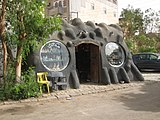| Collecting |
|---|
| Terms |
| Topics |
A souvenir (French for 'a remembrance or memory'),[1] memento, keepsake, or token of remembrance[1] is an object a person acquires for the memories the owner associates with it. A souvenir can be any object that can be collected or purchased and transported home by the traveler as a memento of a visit. The object itself may have intrinsic value, or be a symbol of experience. Without the owner's input, the symbolic meaning is lost and cannot be articulated.[2]
As objects


The tourism industry designates tourism souvenirs as commemorative merchandise associated with a location, often including geographic information and usually produced in a manner that promotes souvenir collecting.
Throughout the world, the souvenir trade is an important part of the tourism industry serving a dual role, first to help improve the local economy, and second to allow visitors to take with them a memento of their visit, ultimately to encourage an opportunity for a return visit, or to promote the locale to other tourists as a form of word-of-mouth marketing. Promotional tchotchke at trade shows serve a similar function.[3] Perhaps the most collected souvenirs by tourists are self-generated: photographs as a medium to document specific events and places for remembrance.[2]
Souvenirs as objects include mass-produced merchandise such as clothing: T-shirts and hats; collectables: postcards, refrigerator magnets, key chains, pins, souvenir coins and tokens, miniature bells, models, figurines, statues; household items: spoons, mugs, bowls, plates, ashtrays, egg timers, fudge, notepads, coasters, and many others.
Souvenirs also include non-mass-produced items such as folk art, local artisan handicrafts, objects that represent the traditions and culture of the area, non-commercial, natural objects such as sand from a beach, and anything else that a person attaches nostalgic value to and collects among their personal belongings. The collecting of natural items such as seashells, plants, or rocks is often discouraged due to ecological damage. Especially the export of endangered plants and animals (or products made of their fur or leather) as souvenirs is strictly regulated by international laws.
A more grisly form of souvenir (here as an example of war booty) in the First World War was displayed by a Pathan soldier to an English Territorial. After carefully studying the Tommy's acquisitions (a fragment of shell, a spike and badge from a German helmet), he produced a cord with the ears of enemy soldiers he claimed to have killed. He was keeping them to take back to India for his wife.[4]
As memorabilia

Similar to souvenirs, memorabilia (Latin for 'memorable (things)'; plural of memorābile) are objects treasured for their memories or historical interest; however, unlike souvenirs, memorabilia can be valued for a connection to an event or a particular professional field, company or brand. Memorabilia can also be related to collections, such as action figures, or video games.
Examples include sporting events, historical events, culture, and entertainment. Such items include: clothing; game equipment; publicity photographs and posters; magic memorabilia; other entertainment-related merchandise & memorabilia; movie memorabilia; airline[5] and other transportation-related memorabilia; and pins, among others.
Often memorabilia items are kept in protective covers or display cases to safeguard and preserve their condition.
As gifts

In Japan, souvenirs are known as omiyage (お土産), and are frequently selected from meibutsu, or products associated with a particular region. Bringing back omiyage from trips to co-workers and families is a social obligation and can be considered a form of apology for the traveller's absence.[6] Omiyage sales are big business at Japanese tourist sites. Unlike souvenirs, however, omiyage are frequently special food products, packaged into several small portions to be easily distributed to all the members of a family or a workplace.
Travelers may buy souvenirs as gifts for those who did not make the trip. A common tradition is to bring a thank-you gift for someone who provided a service such as pet sitting during the trip.
In the Philippines a similar tradition of bringing souvenirs as a gift to family members, friends, and coworkers is called pasalubong.
Gallery
-
Hand-carved wood souvenirs (Chichén Itzá, Yucatán, Mexico)
-
Souvenir statues (Rome, Italy)
-
Souvenir statues (Greece)
-
A souvenir shop along Aleksanterinkatu (Helsinki, Finland)
-
A souvenir shop (Paris, France)
-
A souvenir shop (Egypt)
-
A souvenir stall (London, UK)
-
A souvenir stall (Namibia)
See also
![]() Media related to Souvenirs at Wikimedia Commons
Media related to Souvenirs at Wikimedia Commons
![]() The dictionary definition of souvenir at Wiktionary
The dictionary definition of souvenir at Wiktionary
References
- ^ a b "souvenir". Online Etymology Dictionary. Archived from the original on 2010-11-18. Retrieved 2011-03-05.
- ^ a b "Museum of the personal: the souvenir and nostalgia". byte-time.net. Archived from the original on 2011-07-23.
- ^ Niu, Jiurong (February 2010). The Design and Development of Tourist Souvenirs in Henan (PDF). International Symposium on Tourism Resources and Management. pp. 329–332. Archived from the original (PDF) on 19 October 2017. Retrieved 17 April 2016.
- ^ Reagan, Geoffrey: Military Anecdotes (1992), Guinness Publishing, p. 20, ISBN 0-85112-519-0
- ^ "Aviation and Airline Memorabilia". Collectors Weekly. Archived from the original on 2019-04-19. Retrieved 2015-01-14.
- ^ Witkowski, Terrence H.; Yamamoto, Yoshito (1991). "Omiyage Gift Purchasing By Japanese Travelers in the U.S." Acr North American Advances. NA-18. Archived from the original on 2017-10-19. Retrieved 2015-04-29.






















